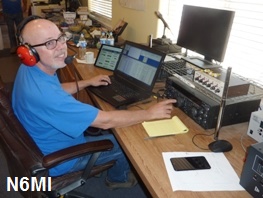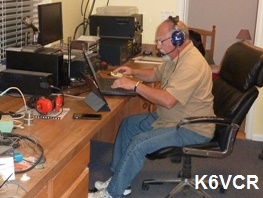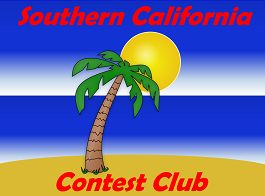Southern California Contest Club
NA Sprint RTTY: September 21 CQ WW DX RTTY: September 27-28 California QSO Party: October 4-5
NA Sprint RTTY: September 21 CQ WW DX RTTY: September 27-28 California QSO Party: October 4-5
A Collection of Past SCCC News Stories (Newest to Oldest)
NAQP CW Claimed Scores
August 2017
K6NA(KI6RRN) SOLP 206,074 WB6NBU SOLP 24,440
N6AA SOLP 123,520 AI6O SOLP 19,080
K6NR SOLP 115,200 WA6URY SOLP 7,150
KM6Z SOLP 68,666 W6KY SOLP 4,636
WQ6X@NX6T SOLP 65,067 AI6DO SOQRP 2,320
XE2MX SOLP 44,622 N6VHF SOLP 690
WN6K SOLP 40,553 N6AB(N6AN) SOQRP 396
N6MU SOLP 31,375
N5ZO (NN5ZO N6CW W6NV) M2LP 351,404
W6KC (W6KC) M2LP 5,200
NC6B (NC6B) M2QRP 1,767
SCCC#1 (K6NA XE2MX K6NR WB6NBU WQ6X) 455,403
SCCC#2 (AI6O N6VHF N6AA W6KY) 147,926
IARU World Championship Claimed Scores
July 2017
N5ZO SOABACWHP 1,168,305 KM6Z SOABACWLP 109,116
N6AA SOABCWHP 749,782 N6MU SOABCWLP 82,935
W6TK SOABHP 560,714 AI6O SOABCWHP 50,046
KI6RRN SOABLP 485,924 W6KC SOABAHP 23,458
WN6K SOABLP 114,478
NX6T (K6AM KK6NON N6EEG N6KI NN6X W6ZAR WQ6X) MSHP 508,564
NAQP RTTY Claimed Scores
July 2017
KI6RRN SOLP 101,024 NE6I SOLP 2,016
WN6K SOLP 40,182 KA6WKE SOLP 1,175
WQ6X@NX6T SOLP 39,491
SCCC #1 (KI6RRN WN6K WQ6X@NX6T KA6WKE W6KY) 181,872
SCCC #2 (NE6I KNC6K) 2,016
CQWW WPX CW Claimed Scores
May 2017
VY2TT(K6LA) SOABHP 10,223,064 N6MU SOABLP 265,963
KI6RRN SOABLP 1,811,300 N6RV SOAABHP 265,088
W6TK SOAABHP 1,419,022 W6QU(W8QZA) SOABQRP 251,996
KM6Z SOABTSLP 662,055 W6KC SOAABHP 130,560
WA6KHK SOAABHP 419,520 NK6A SOAABHP 75,680
WN6K SOABLP 342,405 WA6URY SOABHP 42,090
WQ6X@NX6T(WQ6X N6CY N6KI DL3YM K4RB K6AM) M2HP 7,547,226
CQ WPX SSB Claimed Scores
March 2017
W6TK SOABHP 2,171,016 WQ6X@NX6T SOABAHP 233,266
WN6K SOABLP 696,180 W6QU(W8QZA) SOABQRP 115,977
NC6K SOABAHP 671,957 WA6URY SOABHP 102,589
KI6QDH SOABAHP 588,392 W6JBR SOABHP 44,619
N6RV SOABAHP 490,356 AI6DO SOABAHP 8,262
WA6KHK SOABAHP 353,976 W6KC SOABAHP 4,524
NC6B SOABAHP 327,360 N6HE SOABALP 2,880
N6MI@AF6O (N6MI K6VCR) M1HP 1,481,700



ARRL DX SSB Claimed Scores
March 2017
ZF2MJ(N6MJ) SOABHP 8,607,168 WA6KHK SOUHP 108,108
VY2TT(K6LA) SOABHP 1,664,040 N6ER SOUHP 66,555
W6TK SOUHP 610,836 W6QU(W8QZA) SOABQRP 58,512
WN6K SOABLP 360,360 NC6K SOSBHP 32,640
N6RV SOABLP 231,324 N6HE SOUHP 15,435
KI6QDH SOUHP 206,400 W6KC SOUHP 14,280
NC6B SOUHP 168,156 NK6A(MK6A) SOSBHP 9,975
K7ACZ SOABLP 151,929 W6JBR SOUHP 9,870
WA6URY SOABHP 110,136 AI6O SOABHP 8,424
NX6T (N6KI WQ6X N6NC N6ERD NN6X N6EEG W6ZAR W2PWS N6CY KK6NON) M2HP 1,090,908
ARRL DX CW Claimed Scores
February 2017
VY2TT(K6LA) SOABHP 4,864,266 WA6KHK SOUHP 152,922
K6NA SOABHP 1,413,039 W6KC SOUHP 139,080
W6TK SOULP 881,166 W6KY SOABQRP 136,620
N6RV SOABLP 646,623 W6YA SOSBHP 120,285
NC6K SOUHP 504,210 NK6A SOUHP 97,464
WQ6X@NX6T SOUHP 449,541 KI6QDH SOUHP 60,600
N6QQ SOABHP 433,214 KM6Z SOSBLP 48,750
N6WS SOUHP 417,120 W6JBR SOUHP 43,200
AA6PW SOUHP 344,736 WA6URY SOABHP 41,652
N6MU SOABLP 233,415 WB6NBU SOABLP 32,625
NC6B SOUHP 175,200 AI6O SOABHP 25,872
W6QU(W8QZA) SOABQRP 156,894
CQWW WPX RTTY Claimed Scores
February 2017
KI6VC SOABHP 879,752 KI6QDH SOABHP 183,750
WN6K SOABLP 715,071 W6QU(W8QZA) SOABQRP 153,488
WQ6X@NX6T SOABHP 641,478 N6LL SOABLP 129,532
NC6K SOABHP 627,634 W6KY SOABLP 123,480
W6TK SOABHP 507,834 NE6I SOABHP 94,772
KM6Z SOABLP 444,501 AI6O SOABHP 80,452
N6QQ SOABHP 424,100 W6JBR SOABLP 25,466
NC6B SOABHP 218,624 NK6A SOABHP 23,850
AI6DO SOABHP 190,784
NAQP RTTY Claimed Scores
February 2017
KM6Z SOLP 58,480 KI6VC SOLP 35,778
NC6B SOLP 49,446 W6KY SOLP 24,250
WQ6X@NX6T SOLP 46,800 KI6QDH SOLP 18,000
WN6K SOULP 45,310 K7ACZ SOLP 7,552
NC6K SOLP 39,240 W6JBR SOLP 3,375
SCCC #1 (WQ6X@NX6T NC6K W6KY KI6QDH KI6VC) 164,068
NA Sprint CW Claimed Scores
February 2017
N6MJ@W6TMD SOHP 16,320 W6UE(N6AN) SOHP 8,080
N5ZO SOHP 14,448 KM6Z SOLP 5,811
K6NA SOHP 13,248 WA6URY SOHP 2,079
K6LA SOHP 12,096
SCCC #1 (N6MJ@W6TMD N5ZO K6NA K6LA W6UE(N6AN) 64,192
NAQP SSB Roundup Claimed Scores
January 2017
W6TK SOLP 142,968 K6NA SOLP 5,950
WN6K SOLP 108,559 WB6NBU SOLP 3,854
KI6VC SOLP 45,288 KM6Z SOLP 2,184
KI6QDH SOLP 35,490 NC6K SOLP 300
WQ6X@W7AYT SOLP 8,820
NX6T (W2PWS N6ERD K6GO NA6MB W6ZAR N6KI N6EEG N6NC) M2LP 180,775
SCCC #1 (W6TK WN6K KI6QDH WQ6X@W7AYT W6AFA) 295,837
SCCC #2 (K6NA NC6K WB6NBU K2RP) 10,104
NAQP CW Roundup Claimed Scores
January 2017
N5ZO SOLP 277,056 WN6K SOLP 77,649
XE2MX SOLP 144,628 N6MU SOLP 70,366
N6MJ@W6TMD SOLP 141,759 WQ6X@W7AYT SOLP 24,768
K6NR SOLP 133,560 WB6NBU SOLP 21,606
AC6T@W6RFU SOLP 127,908 W6KY SOLP 12,580
W6TK SOLP 120,120 KQ6ES SOLP 9,720
NC6K SOLP 110,080 WA6URY SOLP 9,936
KM6Z SOLP 102,080 W6UE(N6AN) SOLP 9,028
N6NC@NX6T SOLP 78,775 W6JBR SOLP 3,034
SCCC #1 (K6NA XE2MX AC6T W6TK NC6K) 774,800
SCCC #2 (N5ZO K6NR WN6K WQ6X KQ6ES) 522,753
SCCC #3 (N6MJ N6NC WB6NBU W6KY) 254,720
CQ 160 Meter CW Claimed Scores
January 2017
VY2TT(K6LA) SOAHP 714,119 WN6K SOLP 20,910
K6NA SOHP 226,688 WA6URY SOLP 18,192
N5ZO SOHP 81,396 W6YI SOAHP 15,703
K6NR SOAHP 79,690 AI6O SOHP 14,898
N6KI SOHP 62,160 NC6K SOAHP 11,092
W6TK SOHP 48,216 W6JBR SOLP 4,025
N6LL SOLP 24,100
ARRL RTTY Roundup Claimed Scores
January 2017
NC6B SOHP 80,114 AI6DO SOHP 18,480
WN6K SOLP 59,520 NK6A SOUHP 18,104
KI6VC SOHP 50,490 K6ZZ SOLP 10,502
KM6Z SOLP 40,832 W6JBR SOLP 6,439
KI6QDH SOUHP 25,500 AI6O SOHP 4,182
K6PO SOLP 23,530 W6TK SOLP 2,220
W6KY SOLP 23,373






